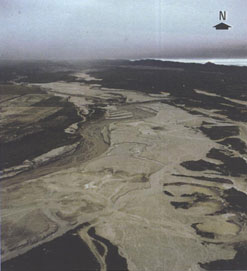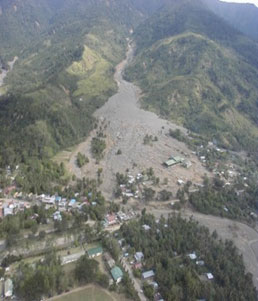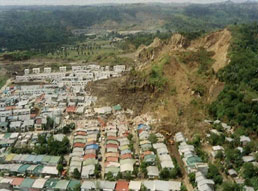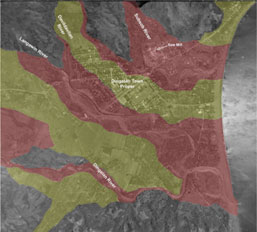Philippines
RECENT TRENDS AND MEASURES
FOR SEDIMENT-RELATED DISASTERS IN THE PHILIPPINES
Senior Geologist, Bureau of Design
Department of Public Works and Highways
There seems to be an increasing trend in the occurrence of sediment-related disasters worldwide due to adverse climatic changes, environmental degradation such as deforestation, rapid urbanization, etc. This disaster is commonly induced by heavy rains during the rainy season and sometimes happens after a strong earthquake.
The Philippines is highly prone to sediment-related disasters because of its tropical climate, it is prone earthquakes, it has active volcanoes and some parts of the country are relatively mountainous. Settlements directly affected by such disasters are those living at the foot of the mountains or alluvial fans, floodplains and deltas. They prefer to stay at these places for easy accessibility and economic reasons. Therefore, more human lives and livelihoods were put at risks to sediment-related disasters.
To address the problem, the government has intensified its identification of hazard prone areas and information dissemination on what to do during a disaster. Measures to mitigate the hazards were recommended but at the moment, the government can only afford to implement temporary measures.
In this paper, several examples of sediment-related disasters due to volcanic activity such as “lahars” and mass movements such as landslides/slope failures will be presented. Measures to address the threat of such hazards will be discussed.
Introduction
The Philippines is frequently devastated by natural disasters and among them are due to sediment-related disasters. Several cases of rain induced “lahars”, debris flows and landslides or slope failures have destroyed properties, infrastructures and claimed human lives living in mountainous areas or at the foot of mountains or alluvial fans, in the floodplains and deltas.
The country is highly prone to sediment-related disasters because it has abundant rain during the rainy season, it is prone to earthquakes, it has active volcanoes and some parts of the country are mountainous. Other factors are presence of highly weathered rocks, steep slopes, denuded slopes due to man-made practices of illegal logging, slash and burn or “kaingin” practices, conversion of forest land to other crops, illegal mining, etc. In addition, the landscape is completely altered by housing and infrastructure development.
More human lives and properties were put at risk because settlements are located on unstable slopes, at the foot of the mountains or alluvial fans, floodplains and deltas for easy accessibility and economic reasons.
SEDIMENT- RELATED DISASTERS
Many sediment-related disasters have already struck the country in the past. These disasters commonly occur at the onset of the rainy season. Examples of the types of sediment-disasters that have devastated some parts of the country are as follows:
Mudflow or “Lahar”
Mudflow and “lahar” are often interchangeably used with each other. However, mudflow is the term used for materials that is at least 50% sand, silt, and clay-size materials, while “lahar” refers to a rapidly flowing mixture of rock debris and water from a volcano (Smith and Fitz, 1989, p. 373).
Mount Pinatubo, a stratovolcano, located in the island of Luzon has been in deep slumber for almost four centuries (Tayag et al, 1994). It was not even known as an active volcano not until its violent eruption on June 15, 1991.

Fig. 1 – Lahars at Pasig-Potrero River, Mount Pinatubo.
It was considered as one of the biggest volcanic eruption of the century and it has created a caldera of about 2 kms in diameter. It has emplaced billions of volcanic materials that buried most of the pre-eruption drainages around the volcano. As a consequence, ashfalls, pyroclastic falls and “lahars” buried the surrounding areas but human casualties were minimal (Fig. 1). However, the damages caused by “lahar” are of unprecedented magnitude and of a lingering nature. Its impact is widespread and costly to the government.
Debris Flows
Debris flow denotes material that contains a relatively high percentage of coarse fragments (Varnes, 1958, pp. 37-38). It results from unusually heavy rainfall, occur in steep slopes or mountain slopes with thick soil and vegetation has been removed by “kaingin” or slash and burn practices and erosion. It frequently starts as small soil-laden streams of water that quickly grow in size and transporting power. These flows commonly follow pre-existing drainage courses, incorporating trees and bushes, and everything in their path. The moving mixture of water, soil, rock and vegetation most commonly has the consistency of freshly mixed concrete. Because of their high density, huge boulders may be rolled along the flow. Debris flows may extend for miles before they drop their loads at a lower gradient or at the base of a mountain front.

Fig. 2 - Debris flow along Subsob River , Dingalan, Aurora .. (Source: Dr. R. Quebral et al)
In November 2004, heavy rains poured continuously on areas surrounding the Sierra Madre Ranges brought about by the passage of several typhoons. Debris flows and flashfloods greatly affected the towns of Real, Infanta, Nakar in Quezon and Aurora Provinces (Fig. 2).
Human lives were lost since communities were built over old alluvial fans and old river channels. This shows that the people are living in hazard prone areas but maybe they are not aware of it. However, most of the victims blamed the tragedy to illegal logging.
Landslides and Slope Failures
Landslides and slope failures are often used synonymously with each other. However, the difference in the usage of these terms is shown in Table 1.
In the evening of August 2, 1999, a landslide occurred at Cherry Hills Subdivision in Antipolo City, Rizal Province. Instantly, fifty-nine persons died, thirty-two were endured and one (1) was missing. About 400 houses were destroyed and more than a hundred families were displaced (Fig. 3).
Investigations showed that the average slope in the area averages to 20%, enough to trigger downslope movement of unstable materials. Heavy rains and other man-made activities have resulted in the eventual collapse of the slopes. Indications of an impending slope failure occurred four to five months before the disaster. Early warnings on the part of the developer and awareness of the residents on the changes in their surroundings could have saved lives and injuries.
| Landslide | Slope Failure | |
| Geology | Very often occur in places with specific geology or geological structure. | Not much related to geology |
| Characteristics of soils | Sliding takes place with a slip surface mainly in the clayey soils. | Often takes place in sandy soils (decomposed granite, volcanic ash,Shirasu). |
| Topography | Takes place in gentle slopesof inclination 5o-20o and very often shows a platform like topography in the upper section | Often takes place in steep slopes with inclination over 20o |
| Condition of sliding activity | Continuous and recurrent | Occurs suddenly |
| Velocity of displacement | Generally the velocity is low with 0.001 mm/day to 10 mm/day. | Velocity is extremely high with over 10 mm/day. |
| Soil mass | Disturbance of the soil mass is small and very often moves while maintaining the original form. | Soil mass is disturbed. |
| Causes of slide | The influence of groundwater is very high. | Largely influenced by rainfall and rainfall intensity. |
| Scale of slide | The scale is large, 1-100 ha | Scale is small. |
| Indications | Development of cracks, subsidence, emergence and variation of groundwater can be observed before the slide. | Takes place suddenly with very little warning. |
Occurrence of slope failures is common along the major highways traversing the mountain regions of the country especially at the onset of the rainy season. These are mostly triggered by heavy rains but some of the major causes are drainage problems, wrong cutting of slopes, lack of vegetation, dumping of spoils on cliff side slopes and many others. Other road sections with slope protection/stabilization works repeatedly fails because these structures are founded on old landslide materials.

Fig. 3 - Cherry Hills Landslides (source: MGB, DENR).
AGENCIES INVOLVED IN HAZARD MITIGATION
Sediment disasters cannot be prevented or accurately predicted from occurring but its damaging effects can be minimized if appropriate measures are undertaken. This can be achieved by instituting non-structural measures such as risk identification, assessment, monitoring and early warning and by structural measures such as the construction of sabo dams and dikes to protect settlements from the direct hit of such disaster. Some of the government agencies that are involved in hazard identification and mitigation are as follows:
Philippine Institute of Volcanology and Seismology (PHIVOLCS)
The agency have nine (9) observatories which are located at Taal, Mayon, Canlaon, Mambucal, Cabugnaan, Bulusan, and Hibok-hibok volcanoes which issues regular updates on volcanoes showing restlessness. Rain gauges and experimental acoustic flow monitors were also installed near the drainages of Mount Pinatubo to monitor “lahars”. It has also prepared hazard maps related to volcanoes and earthquakes.
In view of the recent disaster in Quezon and Aurora Provinces, PHIVOLCS will help in strengthening the disaster preparedness of the municipalities of Real, Infanta and Nakar to geologic and meteorological hazards in collaboration with the Department of Science and Technology (DOST). The expected outputs of the said activities are:
- 1:10,000 scale hazard and risk maps for Real, Infanta and Nakar (REINA)
- three (3) community based disaster warning set-ups>
- nine (9) workshops (3 workshops per municipality)
- one trauma training module to be conducted by the Office of Civil Defense (OCD) of the National Disaster Coordinating Council (NCC)
- Technical Report
Mines and Geosciences Bureau (MGB)
The said agency under the Department of Environment and Natural Resources after the Cherry Hills landslide tragedy spearheaded the issuance of Department Administrative Order (DAO) No. 9637, requiring private entities and government agencies to conduct an engineering geological and geohazard assessment (EGGA) prior to design and construction of housing and infrastructure projects. The agency conducts geohazard assessment of settlements, industrial zones, infrastructure and civil works. It also provides technical assistance for physical framework and land use planning. It also conducts structural geology and engineering geological evaluation. It has already prepared landslide and flood hazard maps using remote sensing and GIS techniques of some areas and related information materials to raise public awareness.
The MGB and PHIVOLCS Inspectorate Team have prepared a Flood Hazard Susceptibility Map of the areas affected by flashfloods/debris slows in Quezon Provinces (Fig. 4).

Fig. 4 – Flood Hazard Susceptibility Map (Quezon) prepared by Dr. R. Quebral et al.
They also recommended for the evacuation of areas highly susceptible to said disasters. Other measures include: removal of alluvial dams along river channels to prevent diversion of river courses during rainy seasons; construction of dikes on both sides of the river channel, formulation of warning system, adoption of proper land use zoning and immediate action on the part of the local government units (LGU) of acquiring identified relocation sites.
Philippine Atmospheric, Geophysical and Astronomical Services Administration (PAGASA)
The agency will be conducting hazard mapping and vulnerability analysis. This study will cover meteorological and hydrological hazards. In the hazard mapping, nature, frequency and magnitude of hazards will be presented in maps. In the vulnerability analysis, areas and assets that are more particularly susceptible to hazard shall be identified. The agency have also formed a mission-oriented team, the Special Tropical Cyclone Reconnaissance, Information Dissemination and Damage Evaluation (STRIDE) Team, with a vision of providing decision-and policy-makers a real time information in the implementation of mitigation strategies to limit the damages caused by typhoons on infrastructure, agriculture, forestry, and loss of human life.
Department of Public Works and Highways (DPWH)
The agency is mostly involved in implementing structural measures to mitigate sediment-related disasters. Sediment-retaining structures (sabo dams) and dike systems were constructed to trap and contain sediments upstream and ensure its continuous drainage downstream has been implemented in Mount Pinatubo and Mayon Volcano in Albay. Measures along the Pasig-Potrero River Basin, one of the rivers draining Mount Pinatubo, are as follows:
Urgent Measures
- reinforcement of the west bank of the Baluyot Channel
- raising of the Sta. Barbara Bridge or Approaches
- dredging in the Delta Area
- repair of the southwest (SW) corner of the Mega dike
- excavation of Baluyot
Short Term Measures
- construction of the San Fernando – Sto. Tomas – Minalin Tail Dike and Bacolor Evacuation Road
- raising of the SW Mega Dike
- construction of closure dikes
- Channel realignment of Sapang Labuan River/Baluyot
- Pilot Channel Dredging and Third River
Medium Term Measures- dowstream channel passing Sasmuan
The DPWH will also be involved in the “Study on Risk Management for Sediment-Related Disasters on Selected National Highways Nationwide.” The countermeasures against such disasters implemented at different problem areas in the country were as follows:
- restraint works
- drainage works: surface drain, subsurface drain
- protection of slope with vegetation
- protection of slopes with structures: concrete spraying; stone or block and concrete plastering; precast and cast-in-place cribworks
- removable of unstable masses
- countermeasure works
- improvement of the shape of slopes
- retaining wall works
- pile works
- counterweight fills
- Others
- protection works: catch walls
- rockfall preventive works - rockshed
CONCLUSION
Identification of disaster-prone areas and early warning of the occurrence of sediment-related disasters as exemplified in the areas surrounding Mount Pinatubo is still the best option to avoid it. Likewise, recognition of the indications for an impending landslide/slope failure and not ignore them could have saved lives in Cherry Hills. These hazards could have been avoided also if hazard zonation has been included in the planning of private and government projects and in policy decisions.
For landslides/slopes failures along major highways, disasters could have been avoided if drainage has been given attention, slopes were properly designed, spoils were dumped on pre-determined sites prior to construction and geological/geotechnical investigation was conducted prior to the design of mitigation structures.
RECOMMENDATIONS
Sediment-related disasters posed a threat to both people and their properties, as well as to our country's infrastructure, hence, the following actions should be undertaken:
Table 2. Drainage-basin parameters to be monitored.| Hydrology | River discharges (water and sediment)Water qualityExtension of drainage network (changing channels patterns |
| Geomorphology | Erosion on selected slopesChannel bed and bank erosionSedimentation within channels, deltas, lakes, and reservoirsSlope stability |
| Soils | Rates of erosionChanges in physical structureChanges in chemical properties |
| Vegetation | DepletionChanges in character |
| Climate | Rainfall – amount, durationRainfall erosivityTemperature |
- Government agencies should closely coordinate with each other regarding their activities on hazard vulnerability and risk assessment to avoid duplication of efforts and maximize the use of limited government resources;
- Incorporate the results of hazard zonation in both planning and policy decisions (including legislation).
- An effective Drainage-Basin (Watershed) Management should also be implemented and should be an inter-agency undertaking. Parameters to be monitored is shown in Table 2.
- A comprehensive land use plan should be prepared with inputs from concerned government agencies.
- Massive information campaign of when and where are the likely occurrence of such hazards should be conducted.
- LGU's should implement the land use plan and be actively involved in the information campaign of the government.
- DPWH engineers should consult with concerned government agencies in order to determine the causes of the disaster so that the most appropriate countermeasure can be selected. Geological and geotechnical investigation should be conducted prior to design of structural measures.
- If funds are available, Protective measures against sediment-related disasters should include: (a) large capacity culverts, upslope structures such as dikes; (b) low dams or levees around critical structures; (c) diverting structures; (d) afforestation of the source area; and (e) drainage at the head of previous slide masses.
Acknowledgements
This paper would have not been possible without the full support and assistance extended by the following: Toshiyuki Kano and Wataru Sakurai of JICA and Ms. Dolores Hipolito of the Flood Control and Sabo Engineering Center (FCSEC), DPWH for giving me the chance to present this paper to this symposium; Dr. Rey Quebral, Salve Laserna and G. Bascos of the Geological Surveys Division of MGB, DENR and T. C. Bacolcol of PHIVOLCS, Department of Science and Technology (DOST) for the data and photos of Dingalan, Aurora Province in Luzon; Engr. Marceliano A. Carlota II of the Hydraulics Division, Bureau of Design (BOD), DPWH for providing data of Mt. Pinatubo, etc. Lastly, I would like to express my sincere thanks to the organizers of this symposium, the Japan Society of Erosion Control Engineering for making this trip and everything possible.
REFERENCES
Cooke, R.U. et al, 1990. Geomorphology in Environmental Management. A New Introduction, 2nd Edition, Clarenden Press, Oxford
Nippon Koei Co., Ltd. et al,2001. Report on Pinatubo Hazard Urgent Mitigation Project – Phase II
Quebral, R.D. et al, 2005. Flood Susceptibility Assessment of Dingalan, Aurora Province
Umbal, Jesse V., 1997. Five Years of Lahars at Pinatubo Volcano: Declining but still Potentially Lethal Hazards, Journal of the Geological Society of the Philippines.
Watari Masasuke, , 1990. Landslide and Its Prevention, Nippon Koei Co., Ltd.
Proceedings of the National Conference of Landslide and Slope Failure Control, Slope Failures in Japan
Technical Standard for the Measures Against Debris Flow (Draft), June 1988, ISSN 0386-5878, Technical
Memorandum of PWRI No. 2632, Sabo (Erosion Control) Division, Sabo Department, Public Works
Research Institute, Ministry of Construction, 1-Asahi, Tsukuba City, Ibaraki Prefecture, 305 Japan.
(Quotation literature: International Symposium on Utilization of Disaster Information~Organizing and Sharing Disaster Information in Asian Country~(JSECE Publication No.44), Copyright © The Japan Society of Erosion Control Engineering)